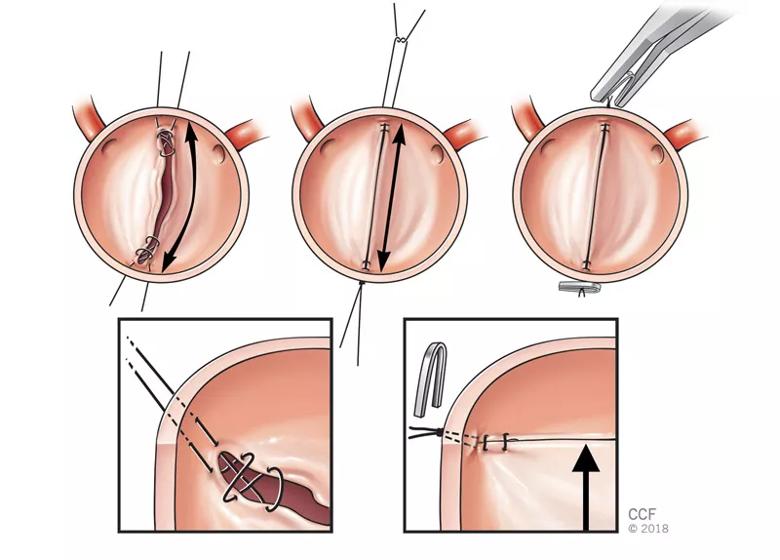Advertisement
Shown to be effective, durable option for regurgitation at experienced centers

Only 1 in 10 patients undergoing surgical aortic valve repair required reoperation within a decade after surgery, report investigators with the largest series of aortic valve repairs published to date. Durability was particularly strong for patients undergoing repair with annular support and those receiving commissural figure-of-8 suspension sutures.
Advertisement
Cleveland Clinic is a non-profit academic medical center. Advertising on our site helps support our mission. We do not endorse non-Cleveland Clinic products or services. Policy
“We’ve shown that, at experienced centers, valve repair is effective and durable for treating aortic regurgitation,” says principal investigator Lars Svensson, MD, PhD, Chairman of Cleveland Clinic’s Miller Family Heart & Vascular Institute. “But only a handful of centers across the U.S. will attempt aortic valve repairs, as these procedures require a steady number of cases to maintain expertise and skills.”
One of those centers is Cleveland Clinic, where all 1,009 aortic valve repairs in this new series were conducted. The report was published online by Annals of Thoracic Surgery in December.
While valve replacement is the standard of care for patients with severe aortic valve dysfunction, the less-common approach of aortic valve repair holds several advantages for appropriate patients with aortic regurgitation. First there’s the potential for extended durability, particularly for patients younger than 65. There’s also freedom from the need for lifelong anticoagulation required with mechanical valves and a reduction in the risks of stroke and infection with repair versus replacement.
“We perform aortic valve repairs as minimally invasive keyhole operations, and previous data from our group have shown that hospital mortality in these procedures is very low,” Dr. Svensson notes. “For instance, mortality was just 0.41 percent in our study of 728 patients undergoing repair of a bicuspid aortic valve, which occurs in 1 to 2 percent of the population. So we knew that repair was safe, and much progress has been made in avoiding early repair failure.”
He explains that the current study was undertaken to address the scarcity of data on late outcomes from aortic valve repair and to better inform guidelines on patient selection and repair durability.
Dr. Svensson and colleagues reviewed records for all 1,124 patients scheduled for elective primary aortic valve repair at Cleveland Clinic from January 2001 to January 2011. Most patients had aortic regurgitation (75 percent), followed by aortic stenosis (6 percent), and both regurgitation and stenosis (3.4 percent). The remaining 15 percent had miscellaneous indications.
Advertisement
Ten percent of patients had their planned repair aborted and underwent replacement; significant risk factors for conversion to replacement were more-severe aortic regurgitation and valve calcification. The remaining 1,009 patients underwent repair via various techniques, including cusp repair with commissuroplasty in nearly half of cases (48 percent) as well as commissural figure-of-8 suspension sutures, debridement, free-margin plication or resection, and annulus repair with resuspension, root reimplantation or root remodeling.
In-hospital outcomes among these 1,009 patients included death in 1.2 percent, stroke in 1.3 percent and reoperation for valve dysfunction in 1.4 percent.
Immediate postoperative aortic regurgitation grade was none/mild in 94 percent of patients, moderate in 5 percent and severe in 1 percent. At 10 years post-repair, aortic regurgitation grade was none in 20 percent, mild in 33 percent, moderate in 26 percent and severe in 21 percent.
Long-term outcomes were as follows:
“While survival during the first year is somewhat less than for the matched general population,” says Dr. Svensson, “these results show that aortic valve repair can be done safely and with early mortality and morbidity similar to those with valve replacement.”
He noted several important additional findings:

Figure. Illustration of aortic valve repair with figure-of-8 (Svensson) suspension sutures, which were associated with reduced reoperative risk in the study. This stitch increases the area of apposition for the valve leaflets and elevates them to achieve more tension. The result is greater contact area and apposition, which may provide redundancy if the leaflets stretch over time.
Advertisement
Dr. Svensson says the best candidates for aortic valve repair versus replacement include patients with a three-leaflet valve with an enlarged aortic root as well as younger patients with a bicuspid valve with no perforations and without calcification. “I now offer repair to about 70 percent of patients with a bicuspid valve and to about 90 to 95 percent of those with a three-leaflet valve with an enlarged aortic root,” he explains.
Rates of aortic valve repair may ultimately increase further if current explorations of transcatheter aortic valve repair via a transfemoral approach pan out. “But for now,” Dr. Svensson concludes, “surgical repair allows experienced centers to offer appropriate patients survival rates and repair durability that match what we see with bioprosthetic aortic valve replacement — without some of the potential downsides of replacement.”
Advertisement
Advertisement

Surprise findings argue for caution about testosterone use in men at risk for fracture

Findings support emphasis on markers of frailty related to, but not dependent on, age
![GettyImages-1252287413 [Converted]](https://assets.clevelandclinic.org/transform/StoryPanel/350804b2-f1e4-4d97-a277-9629cf45af3e/23-HVI-4120348_redlining_650x450_jpg?w=3840&q=75)
Large database study reveals lingering health consequences of decades-old discrimination

Additional analyses of the two trials presented at 2023 ESC Congress

Prospective SPIRIT-HCM trial demonstrates broad gains over 12-month follow-up

An ACC committee issues recommendations to accelerate sluggish progress

Review of our recent experience shows it’s still a safe option

Machine learning may improve risk prediction and guide therapy